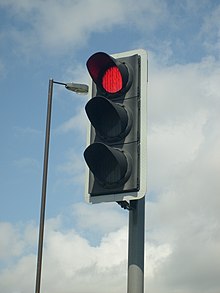
Traffic lights, traffic signals, or stoplights – also known as robots in South Africa,[1][2] Zambia, and Namibia – are signaling devices positioned at road intersections, pedestrian crossings, and other locations in order to control the flow of traffic.[3]
Traffic lights normally consist of three signals, transmitting meaningful information to road users through colours and symbols, including arrows and bicycles. The regular traffic light colours are red to stop traffic, amber for traffic change, and green for allowing the traffic, arranged vertically or horizontally in that order. Although this is internationally standardised,[4] variations in traffic light sequences and laws exist on national and local scales.[5]
Traffic lights were first introduced in December 1868 on Parliament Square in London to reduce the need for police officers to control traffic.[6] Since then, electricity and computerised control have advanced traffic light technology and increased intersection capacity.[7] The system is also used for other purposes, including the control of pedestrian movements, variable lane control (such as tidal flow systems or smart motorways), and railway level crossings.
- ^ "robot – definition of robot in English – Oxford Dictionaries". Oxford Dictionaries – English. Archived from the original on 14 August 2018.
- ^ "see robot – definition of robot in Dictionary of South African English". Editor's Note: The origin of 'robot' used as 'traffic light' is from the English translation of the play R.U.R. by Karel Čapek which debuted in England in 1923 which introduced the term 'robot' to an English audience. For a short time in England it was fashionable to use 'robot' for 'traffic light' from the late 1920s, when traffic lights were being installed in England. This usage travelled to South Africa in the early 1930s, when they had their first traffic lights installed, and where it continues to be used almost 90 years later, while 'robot' for 'traffic light' fell out of usage in England. See Foster, B. 1970. The changing English language. Harmondsworth, Middlesex: Penguin.
- ^ McShane, Clay (March 1999). "The Origins and Globalization of Traffic Control Signals" (PDF). Journal of Urban History. 25 (3): 379–404. doi:10.1177/009614429902500304. S2CID 110125733. Retrieved 27 October 2019.
- ^ Convention on Road Signs and Signals of 1968; European Agreement Supplementing the Convention; and, Protocol on Road Markings, Additional to the European Agreement : (2006 consolidated versions). New York: United Nations. Economic Commission for Europe. Transport Division. 2007. ISBN 978-92-1-139128-2. OCLC 227191711.
- ^ see Variations in traffic light operation
- ^ Thames Leisure. "12 Amazing Facts About London". Archived from the original on 7 January 2017. Retrieved 25 January 2017.
- ^ Sessions (1971), p. 141.